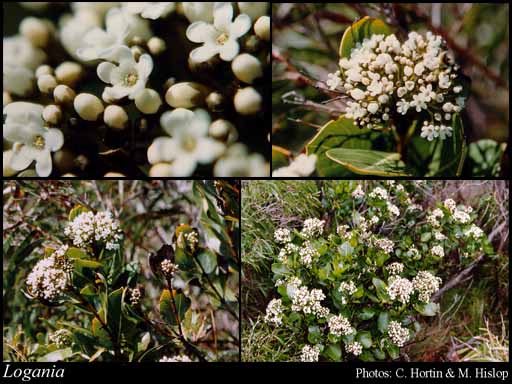- Reference
- Prodr.Fl.Nov.Holland. 454 (1810)
- Name Status
- Current

Scientific Description
Common name. Loganias. Family Loganiaceae.
Habit and leaf form. Shrubs, or herbs. Leaves cauline. To 0.1–4 m high. Mesophytic. Not heterophyllous. Leaves minute, or small; opposite; decussate; leathery, or membranous; petiolate, or subsessile, or sessile (sometimes sessile leaves appear to be petiolate); simple. Leaf blades dorsiventral; entire; linear, or ovate, or obovate, or oblong, or elliptic; pinnately veined; cross-venulate. Mature leaf blades adaxially glabrous, or pubescent; abaxially glabrous, or pubescent. Leaves with stipules. Stipules interpetiolar (or forming a short sheath); free of one another (rarely), or concrescent (usually). Leaf blade margins entire.
Reproductive type, pollination. Fertile flowers hermaphrodite, or functionally male, or functionally female. Unisexual flowers present (in some species), or absent. Plants hermaphrodite, or dioecious (when flowers are unisexual).
Inflorescence and flower features. Flowers aggregated in ‘inflorescences’, or solitary (usually); not crowded at the stem bases; terminal. Inflorescence few-flowered, or many-flowered. Flowers in cymes (where applicable). Inflorescences simple, or compound (usually); terminal (often appearing axillary when developing from short lateral shoots). Flowers pedicellate; bracteate; minute, or small; regular; 5 merous (commonly), or 4 merous (rarely); tetracyclic. Free hypanthium absent. Perianth with distinct calyx and corolla; 10 (commonly), or 8 (rarely); 2 -whorled; isomerous. Calyx present; 5 (commonly), or 4 (rarely); 1 -whorled; gamosepalous; lobed; lobulate. Calyx lobes markedly longer than the tube. Calyx hairy (ciliate); imbricate; exceeded by the corolla. Corolla present; 5 (commonly), or 4 (rarely); 1 -whorled; gamopetalous; lobed; lobulate. Corolla lobes markedly shorter than the tube. Corolla imbricate; campanulate; regular; hairy abaxially, or glabrous abaxially (when the surface is glabrous, it can be hairy on the rim; when the surface is hairy, it is with varying degrees of hairiness and distribution); hairy adaxially, or glabrous adaxially (when the surface is glabrous, it can be hairy on the rim; when the surface is hairy, it is with varying degrees of hairiness and distribution); plain; white, or yellow. Corolla members more or less entire. Androecial members definite in number. Androecium 5 (commonly), or 4 (rarely; i.e. as many as the corolla lobes). Androecial members adnate; free of one another; 1 -whorled. Stamens 5 (commonly), or 4 (rarely; i.e. as many as the corolla lobes). Staminal insertion midway down the corolla tube, or in the throat of the corolla tube. Stamens just becoming exserted (but not exceeding corolla), or remaining included; all more or less similar in shape; isomerous with the perianth; oppositisepalous; all alternating with the corolla members. Anthers dehiscing via longitudinal slits; introrse. Gynoecium 2 carpelled. The pistil 2 celled. Gynoecium syncarpous; synstylovarious to eu-syncarpous; superior. Ovary plurilocular; 2 locular. Gynoecium median; stylate. Styles 1; simple; attenuate from the ovary; apical; becoming exserted, or not becoming exserted; deciduous (commonly), or persistent (rarely). Stigmas 1; capitate (or oblong). Placentation axile. Ovules 30–50 per locule (‘many’).
Fruit and seed features. Fruit non-fleshy; usually black; dehiscent; a capsule. Capsules septicidal. Dispersal unit the seed. Seeds endospermic. Cotyledons 2. Embryo straight.
Geography, cytology, number of species. World distribution: pantropical, and a few warm temperate. Australian states and territories: Western Australia, South Australia, Northern Territory, Queensland, New South Wales, Victoria, and Australian Capital Territory. A genus of c. 35 species; 19 species in Western Australia; 16 endemic to Western Australia.
Etymology. After James Logan (1674–1751), born in Ireland, emigrated to America with William Penn; governor of Pennsylvania 1736.